Emio Greco en Pieter Scholten repeteren hun nieuwe voorstelling Extremalism in Marseille. De twee dansgezelschappen onder hun leiding, ICKamsterdam en Ballet National de Marseille, zijn voor deze gelegenheid samengevoegd: 30 dansers op het toneel, zes auteurs en ontwerpers in de zaal en ook de ploeg technici bestaat uit Amsterdammers en Marseillais. Ze werken samen aan de grootste productie die Greco en Scholten ooit maakten.
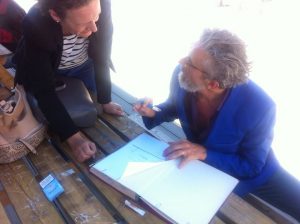
De repetities vinden plaats in het theater van La Friche Belle de Mai, een soort Westergasfabriek-terrein in de voormalige sigarettenfabrieken (Gitanes, Gauloises) aan de noordkant van het oude centrum van Marseille. Schooltuintjes, een enorme skatebaan, een vrije radio: de veryupping lijkt aan La Friche Belle de Mai voorbij te zijn gegaan – al is er een heel goed restaurant. Marseille heeft sowieso weinig last van de zogenaamde gentrificatie. Dat maakt de stad aantrekkelijk. De mensen zijn direct en open, de stad is één grote rafelrand.
Pieter Scholten: “Marseille is een stad van uitersten. Op een vip-party van de burgemeester tijdens het jazzfestival stonden Emio en ik oog in oog met IMF-directeur Lagarde. Tegelijkertijd schuimen mensen hier de vuilnisbakken af naar eten en spulletjes om de volgende ochtend in Quartier Nord te verkopen. De armoede in Marseille is schokkend. Het Ballet National de Marseille stond heel ver van de stad af, daar gaan we verandering in brengen. We willen dat alle Marseillais zich herkennen in het gezelschap.” En dus hield het nieuwe BNM audities in het befaamde ‘moeilijke’ stadsdeel Quartier Nord.
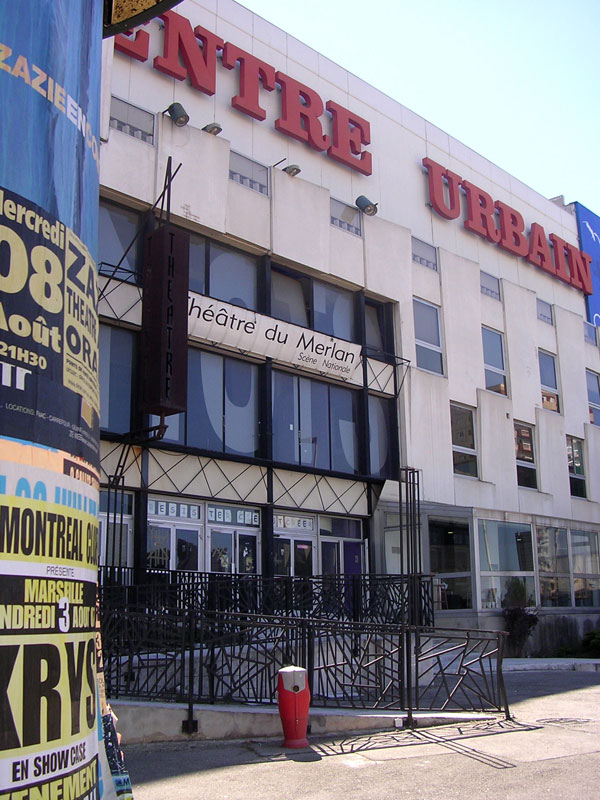
Scholten: “Théâtre du Merlan is een soort Meervaart. Iedereen mocht meedoen, mits ze maar in Quartier Nord woonden. Uiteindelijk hebben we drie dansers uitgenodigd om een aantal dagen naar het huis van BNM te komen, dat in Quartier Sud ligt, het sjieke deel van de stad. Maar het lukte niet om echt afspraken te maken met deze drie. Er is meer tijd voor nodig, maar deze uitwisseling was een goed begin.”
Een oud-student van mij, nu terug in haar geboortestad om het werk van de onafhankelijke choreograaf Geneviève Sorin over te nemen, is onder de indruk. Léa Canu Ginoux: “Ze zijn voortvarend. Binnen enkele maanden was de B van Ballet uit het logo verdwenen, de M van Marseille domineert nu. Dat is hoopgevend.”
Toch is het geenszins de bedoeling van Greco en Scholten om het ballet de rug toe te keren. Emio Greco: “Het is juist interessant om ons met ballet bezig te houden. Het heeft een enorm appeal. Je bereikt er een groot publiek mee. Onze benadering van dans is gedeeltelijk gebaseerd op ballet. In Amsterdam zetten we ons experimentele werk voort. In Marseille verhouden we ons tot de traditie. Het zijn twee lijnen binnen ons werk, die elkaar complementeren en uitdagen.”
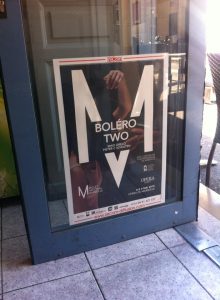 In de stad kom ik affiches tegen van het vorige programma van Greco en Scholten bij BNM. Two en Bolero behoren tot het eerste werk dat de twee dansmakers gedurende hun nu twintigjarige samenwerking maakten. De even meesterlijke als onverzettelijke solo van Greco op de al te bekende muziek van Ravel werd voor deze gelegenheid door het hele gezelschap ingestudeerd en met orkest uitgevoerd. Ook Le Corps du Ballet werd met BNM hernomen en herschreven (zie hier een mooie videomontage). Delen van deze ‘schetsen’, zoals Scholten zegt, komen terug in Extremalism. Maar ook materiaal uit het duet Extra Dry speelt een prominente rol in de nieuwe productie.
In de stad kom ik affiches tegen van het vorige programma van Greco en Scholten bij BNM. Two en Bolero behoren tot het eerste werk dat de twee dansmakers gedurende hun nu twintigjarige samenwerking maakten. De even meesterlijke als onverzettelijke solo van Greco op de al te bekende muziek van Ravel werd voor deze gelegenheid door het hele gezelschap ingestudeerd en met orkest uitgevoerd. Ook Le Corps du Ballet werd met BNM hernomen en herschreven (zie hier een mooie videomontage). Delen van deze ‘schetsen’, zoals Scholten zegt, komen terug in Extremalism. Maar ook materiaal uit het duet Extra Dry speelt een prominente rol in de nieuwe productie.
Werkwijze
Het is de eerste week dat de dansers van de twee gezelschappen bij elkaar komen. Ook de IJslandse componist Valgeir Sigurdsson, die met Björk en met Stephen Petronio werkte, en de Nederlandse ontwerper Henk Stallinga, wiens indrukwekkende lichtsculptuur Chain Reaction onderdeel uit gaat maken van Extremalism, zijn hard aan het werk. Pieter Scholten: “Ik weet nog helemaal niet waar het heen gaat, het is zo’n groot project, het vergt zoveel afstemming. Het is echt een kwestie van de goede connectie vinden in ’the heat of the moment’.”
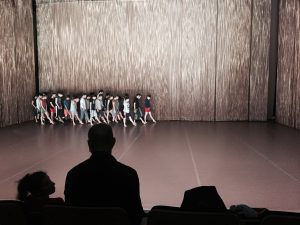
De delen die, op de dagen dat ik er ben, gerepeteerd worden, ogen sober, intens en bieden een caleidoscopische blik op het werk van Scholten en Greco in de afgelopen decennia. Scholten: “We hernemen en citeren materiaal uit al die jaren. Het gaat er toch om dat al die nieuwe mensen vertrouwd raken met de intense inzet van het werk. Voor hen is het nieuw. Voor ons is het juist een kwestie van terug naar de essentie.”
Het ’tableau de la troupe’ zoals zich dat tijdens de repetities manifesteert, oogt ontspannen en vertoont niet het uiterlijke zelfbewustzijn dat grote dansgezelschappen vaak tekent. De dansers zijn vooral harde werkers, op zoek naar hun plek in een immense zee van beweging. De secties zijn lang en intens en vragen veel van de dansers. Danseres Kelly Hirina: “Het is voor dansers altijd enorm wennen aan Emio’s benadering. Je moet als danser zelf uitvinden hoe je het werk aanpakt, je eigen weg vinden in het materiaal. De balletmensen zijn gewend om via de techniek controle te hebben, boven het materiaal te staan. Dat werkt bij Emio en Pieter niet.”
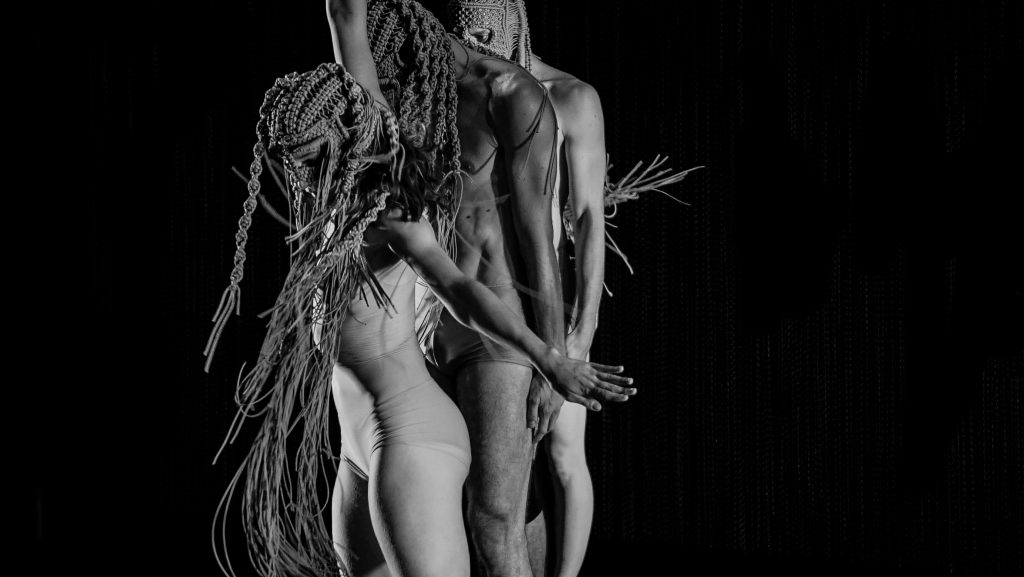
Lachend bevestigt Pieter Scholten dat het inderdaad ontspannen is, relatief dan. “Het is ook nieuw voor ons. Met de grote groep van hier hebben we van buiten naar binnen moeten werken, vanuit de vorm, wat raar is voor ons. Het werk moet als het ware uitgeschreven worden, wat we nooit deden. Het blijft altijd een vorm van improvisatie, hoe vaak iets ook wordt opgevoerd. De zes ICKers hebben die achtergrond natuurlijk wel, maar zij zijn pas net aangekomen. Ze kennen de huidige choreografie, de preciese frases nog niet. In Extremalism komen de twee manieren van werken, van binnenuit of van buiten naar binnen, bij elkaar.”
Compositie en montage vallen samen
De voorstellingen van Greco en Scholten volgen niet het oude patroon van een dansproductie, waarbij een choreografie op vastgelegde muziek in een studio wordt gemaakt en dan op het laatste moment, in de overgang naar het theater, wordt voorzien van licht en decor. Compositie en montage vallen samen. Iedereen heeft tijd nodig om uit te zoeken wat er allemaal wel en niet kan, past en wringt, esthetisch of technisch, en of de uiteindelijke keuze dan voor het wringende of het passende moet zijn. Als laatste beslissen Greco en Scholten, maar vaak ook herzien zij hun beslissingen. Het werk is nooit af.
Over de keuze voor componist Valgeir Sigurdsson zegt Scholten: “Het is belangrijk dat Sigurdsson elektronische en akoestische muziek combineert, een gevoel voor popmuziek heeft en bekend is met de werking van een dansvoorstelling. Eerder schreef hij en speelde hij live de soundtrack van Architecture of Loss voor Stephen Petronio.” Bij het eten ’s avonds merkt Sigurdsson op hoe prettig hij het vindt dat Greco en Scholten de tijd nemen om samen naar de verhouding tussen muziek en de andere elementen te kijken. Bij Petronio was zijn compositie klaar, voordat hij in het theater aan de slag kon. Vervolgens wordt er aan tafel nog druk gediscussieerd over wat precies de muzikale en theatrale bijdrage van Jodie Landau zal zijn, de jonge Amerikaanse zanger, die een door Sigurdsson te componeren ‘song’ zal vertolken tijdens Extremalism.
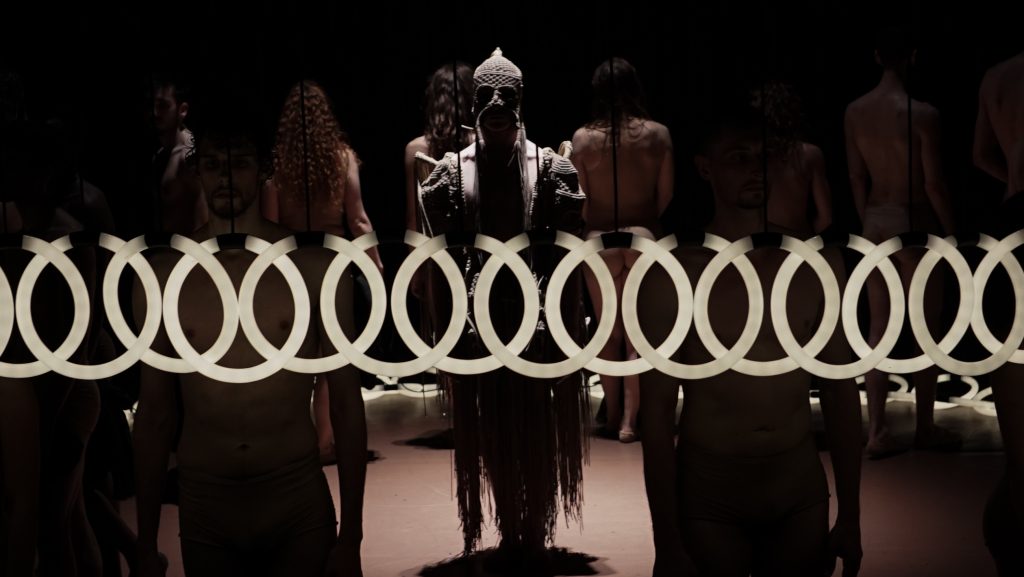
Woeker en Zen
Hernemen, herschrijven en jezelf citeren zijn typerend voor de werkwijze van Greco en Scholten. Dansmateriaal en thema’s banen zich woekerend een weg door hun oeuvre. Naast de meer persoonlijke woeker die uit het werk spreekt: de hoge inzet, de extreme eisen die Greco en Scholten aan zichzelf en hun medewerkers stellen, en de voortdurende druk die dat op alle medewerkers uitoefent, is er ook een brede maatschappelijke woeker die in Extremalism naar voren komt.
Gevraagd naar de rol van verzet binnen zo’n grote groep, die zich steeds richt op gemeenschappelijk materiaal en in een gemeenschappelijke richting beweegt, zegt Scholten: “We zijn er nog niet uit of we ook echt met solo’s en duetten gaan werken, zoals in Corps du Ballet vanwege de ballettraditie. Misschien wordt de groep als geheel wel de enige protagonist van Extremalism. De grote groep spiegelt de maatschappij. Verzet zoals Camus dat beschreef in L’Homme Révolté is heel ingewikkeld geworden. Iedereen wil alles: bewust leven, yoga, gezond eten, niet vervuilen, maar wel je smartphone en je laptop de hele dag bij de hand en een snelle vliegverbinding. Het is een onhoudbare spagaat, een ratrace, waar veel mensen buiten gesloten worden. Het is ook een afweging die Emio en ik persoonlijk moeten maken: kunnen we zo’n instituut dragen, de machtspositie aannemen en tegelijkertijd trouw blijven aan onze artistieke inzet? Uiteindelijk willen raden van toezicht bezoekcijfers en sluitende begrotingen zien. Of je artistiek en sociaal grenzen hebt verlegd, is van secundair belang. Er vindt een nieuw soort ontmenselijking plaats. Er wordt enorm gewoekerd met aandacht en met gevoel. Ik denk dat het verzet er nu uit bestaat toe te geven dat je het niet weet, dat het belangrijk is om twijfel en vermoeidheid de ruimte geven.”
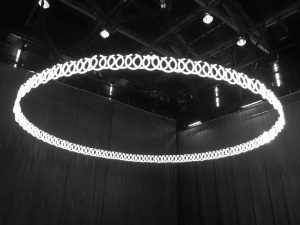
Tijdens de repetities vallen meerdere scènes op waarbij een enkele danser zich losmaakt van de groep, soms tegenover een andere danser komt te staan, zonder dat er verder veel gebeurt. Een zekere loosheid of zen lijkt zich temidden van de drukte te manifesteren, in plaats van drama en conflict.
Het werk Chain Reaction van Henk Stallinga spiegelt mooi het principe van de grote aaneengesloten, maar altijd in eindeloos veel delen uiteenvallende, groep. Simpel opgebouwd uit lusjes licht, bewegen de delen ten opzichte van elkaar als in een ketting. De losse schakeltjes ogen soms strak, maar in hun onderlinge beweging wordt het ook rommelig. Het zorgt ervoor dat de enorme constructie niet als een in beton gegoten theaterbeeld functioneert, maar een fragiele verschijning wordt die een heel organisch ordeningsprincipe in herinnering brengt. Het lijkt de sleutel tot alle aspecten van Extremalism.
Extremalism, wereldpremière Holland Festival, 12 juni Theater Carré, ook nog te zien op 13 juni, 20:30.
Op 12 juni is er een voorgesprek o.l.v. Ariejan Korteweg met ondermeer Johan Reyniers en Peggy Olislaegers over heden, verleden en toekomst van de dans, bezien vanuit de twintigjarige carrière van Greco en Scholten. Aanvang 19:00.
Na Amsterdam is Extremalism in juni nog te te zien in Montpellier en Napels. Voor tournee, zie website ICKamsterdam en Ballet National de Marseille
